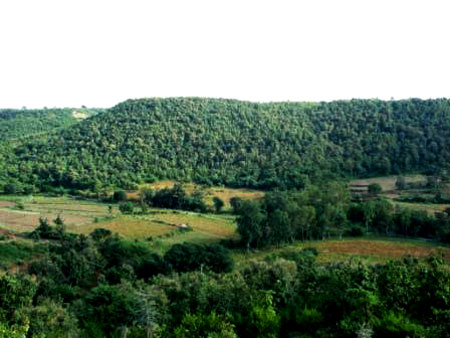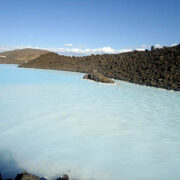When I started my Ph.D., I thought I had clear ideas. I was going to understand water scarcity and how it affected farmers. I was going to try and figure out why the crores of rupees the Indian government spent on water management programmes across the nation were yielding unsatisfactory results.
I had studied about this, worked on this—surely things couldn’t get too cumbersome. And then someone said the word. Epistemology. The science of knowledge. What? I felt discomfort stroke me with its clammy fingers. I get a curious itch in my brain when I don’t understand a word, and this one prodded me incessantly; I couldn’t shake it off, I couldn’t ignore it. It would pop up in conversations and articles. And then came the question: “If a tree falls in a forest and no one is around to hear it, does it make a sound?”

Pratapgarh: Not your typical desert. Photograph by Chandni Singh.
From that tangential thought, to the project I am embarking on today, I slowly appreciated that to unravel anything, we must first explore our constructions of reality. What qualifies as real and what does not? In the context of my work, is Mrs. Kapoor’s lament that she has no water to grow her potted plants in her fifth floor Gurgaon apartment any less real than Rajnath’s helplessness at having his well in a hamlet near Mathura dry up before he irrigates his crops? Percolating from the perplexing to the practical, I decided to allow my research to be all-ears.
I am going to spend the next year listening to people’s stories. Of how water shapes their lives and how they cope with its ever-changing reality. I am setting foot in rural Rajasthan to talk to farmers facing water shortages and narrate their tales. Here, I attempt to take you along my rustic rambles.
While traversing the length and breadth of our magnificent country, the only rule that seems applicable everywhere is that India is alarming and inspiring, stimulating and disconcerting, all at once. When looking at the map, some names jump at you—the metropolitan cities, proud of the concrete jungles they have grown up to be; smaller, fast growing cities, and other towns, their claim to fame being part of the latest breaking news. Amidst all this chaos that is so characteristic of the Indian landscape, a million other places get waylaid—ignored by the traveller, unknown to the larger consciousness. It is in one of these places I find myself in.
Contrary to popular perception, Rajasthan is not all sand dunes and camels. It is also home to large tracts of invigorating forests, replete with wildlife, large water bodies, and most of all, colourful, vibrant people. Pratapgarh is a small, predominantly tribal district in southeast Rajasthan, occupying the area where the Malwa plateau and Aravalli Mountains meet. Carved out of Chittorgarh in 2008, Pratapgarh is the latest district formed in the state. It boasts of a generous average annual rainfall of 850mm, an aberration in a state known for its aridity. However, in spite of all the water Pratapgarh gets, the basalt rocks in the area dissuade water from percolating into the groundwater. With all the rain falling within the monsoon season, it washes away without soaking into the earth. Unable to store this bounty in such a short duration, the people of Pratapgarh dread the summer months which usher in acute water stress.
* * *
Jogilal Meena was bent over his crop, cutting the soyabean stalks industriously. They were stunted, the tallest up to a foot high, while the trifoliate legume I knew from Madhya Pradesh was a luxuriant plant over two-feet high. But it had rained well this monsoon season, surely that was good in this water-scarce region?

Half-rotten maize crops. Photograph by Chandni Singh.
“The rains were heavy, almost 1500mm this year! That’s double of the average rainfall we get. But they were untimely. Our maize rotted away. The fields filed up with water and became ponds. The land was so saturated that if you stepped in one place, water oozed out from another place. The soyabean we grew also did not grow too well. Hopefully the Rabi crop will do better because the soil is moist. This year I plan to grow wheat,” he added proudly. “The paatidaar has promised me some hybrid seed.” The hybrid was said with a flourish, as if unveiling a secret weapon.
I watched as he cut at the nearly dry soyabean. His wife, dressed in a bright orange ghagra and yellow odhni grinned widely, her unabashed gaze almost welcoming me into her world. Their two sons and one daughter helped too. She jokingly told me to grab a sickle, if I was good, I could choose between the sons. Her laughter, honest and loud, was heartening. Each one of them held a sickle in their right hand and wore a curious looking homemade ‘glove’ on their left hand. It resembled more a mitten, or a sock. Fashioned out of waste cloth, roughly sewn and with a string to tighten the mitten around the wrist, this ingenuous glove was a necessity. The soyabean plant can cut through skin with alarming ease. Thus, as the sickle moved rapidly in the right hand, the left hand, protected in its cloak of cloth, grasped the stalks unhindered.
The family had been up since 5 a.m., cutting and bundling the soyabean stalks, and now, in the early evening, the sun continued its unforgiving trajectory across the sky. Stopping to talk to us and to drink some water, Jogilal pointed to the stalks, “Some of the pods are splitting in the sun. The beans will fall to the ground and then we won’t get anything. We must hurry and harvest everything by sunset. I have rented a thresher tomorrow, an added cost.”
As I walked back over the cracked black soil, I watched the maize plants. Half-rotten cobs were hanging on to the stalks, forgotten and unwanted—another commentary on a farmer’s constant struggle with the vagaries of nature and his unflinching will to eke out a living from the land. Jogilal Meena was already planning to grow wheat this winter. Hopefully that would bring in some money. Then he could buy those strong military gloves he had seen in town. The mittens were no good, the children constantly complained of sores.









This is so well written! Congrats and yes, you have got all my attention now! Who knew agriculture could sound so exciting. You have a true gift. Keep at it!
Wow!!! So riveting and informative all at once!! So gripping and enlightening…putting real faces to the often abstract problems surrounding water and livelihoods…I am hooked! Thank you Fungai Machirori for directing me towards this well written and entertaining provocative piece.
Epistemology!!!!!!!!!!!!.. yea.. tell me about it!!! if you any clue what it is, please do share insights.. and for me this is just the beginning of knowing the unknowns..!!!
you have a way with words, my dear. can i have copy of this article sent to my e-mail? thanks
well written, i read ur other article on “VV: happiness” and was about to comment that you might wana use easier vocab to document your experiences, but this one was a breeze to read.
Thanks Varun! I’ll keep that in mind. There’s nothing worse than having plough through writing because the words seem too much.
Wonderful article! As they say water is the oil of the 21st century so I really appreciate reading real life experiences like this.